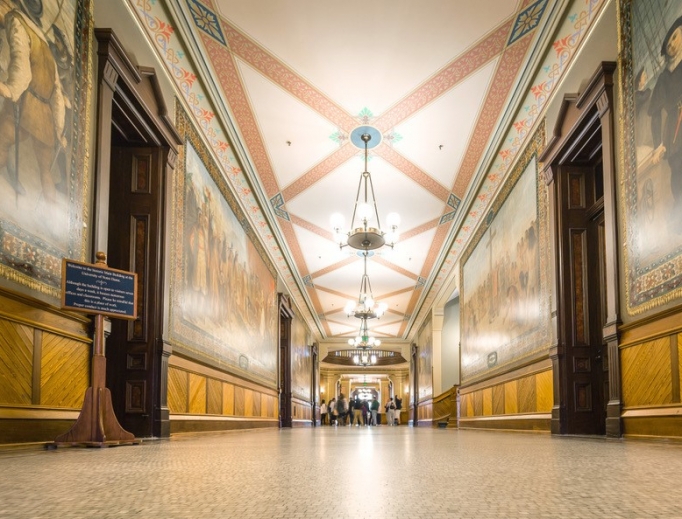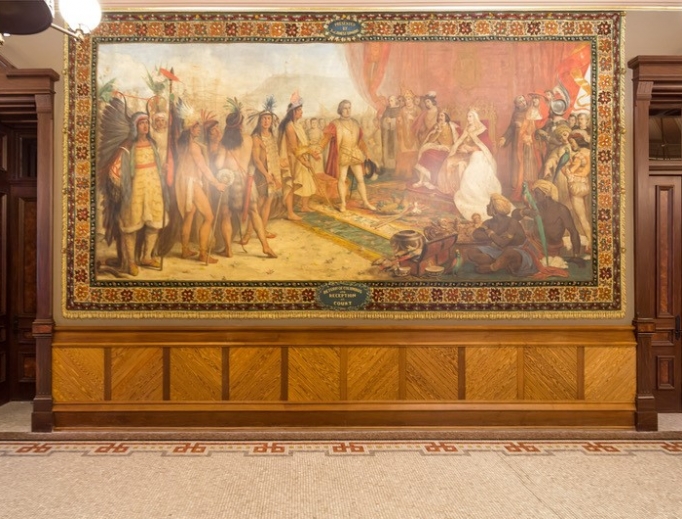Catholic Identity at Stake in Notre Dame Decision on Columbus Murals
University president Father John Jenkins announced in January that the depictions of the Catholic explorer will be covered, to placate critics who find them offensive.

The University of Notre Dame has announced plans to cover up murals depicting the voyages of Christopher Columbus to the Americas in a decision that is being criticized by some Notre Dame faculty and Catholic commentators as diminishing Catholic identity for the sake of political correctness.
“Notre Dame once represented the hopes and dreams of faithful Catholic immigrants. At a time when it seems anti-Catholicism is once again a common prejudice, it’s dismaying that Father Jenkins would disrespect America’s Catholic heritage — as well as the identity of his own university,” said Patrick Reilly, president of the Cardinal Newman Society.
The 12 murals were painted by Italian artist Luigi Gregori between 1882 to 1884 and are displayed on the walls around the ceremonial entrance to the campus’ Main Building. Holy Cross Father John Jenkins, president of Notre Dame, announced the decision on the murals in a Jan. 20 email in advance of Martin Luther King Jr. Day and a weeklong series of campus events on diversity and inclusion.
“We live in a time where university campuses are largely dominated by more politically correct kinds of initiatives, and this has to be understood in that context,” said Holy Cross Father Bill Miscamble, a professor of history at Notre Dame. “It’s nonetheless still surprising that it happened at Notre Dame, on a Catholic university campus. It’s indicative that some of the trends that dominate our more secular campuses have a hold here, as well.”
Reilly attributed the influence of political correctness on campuses like Notre Dame to a concern for prestige and a reaction to the recent Church scandals. “[T]he Church is unpopular in today’s culture — made worse by recent scandals. It’s easy to see, then, why university leaders who are primarily concerned with their social reputation and the prestige of the university would choose political correctness over Catholic identity and truth,” Reilly said.
John Zmirak, author of The Politically Incorrect Guide to Catholicism, said covering up the murals betrays the heritage of Catholic immigrants. “This decision by Notre Dame is impious. It shows no respect for our ancestors and our history, but throws them under the passing bus of political expediency,” Zmirak said.
“Columbus was a key figure in asserting Catholics’ right to reside in the United States. To Protestants who wanted to exclude us, pointing to the Pilgrims as America’s founders, we cited Columbus, to remind them of the role of the Spanish and also the French in discovering and settling the continent for Europeans,” Zmirak added.


‘Skewed and Unfair Portrayal’
Father Jenkins said the decision was in response to feedback he had received from students, faculty, staff and members of the Native-American community. “In recent years … many have come to see the murals as at best blind to the consequences of Columbus’s voyage for the indigenous peoples who inhabited this ‘new’ world and at worst demeaning toward them,” Father Jenkins wrote.
But Father Miscamble said that Columbus was being blamed for atrocities committed by others after his arrival to the Americas. “[Father Jenkins] gives a deeply skewed and unfair portrayal of Columbus; and if, indeed, Columbus is to be blamed for all that is bad that came to the New World, should he not be given credit for bringing the good that came to the New World? And among that good is, of course, Christianity itself,” Father Miscamble said.
“Notre Dame’s decision to cover up the historic Columbus murals continues a pattern of feeble witness and, all-too-often, outright repudiation of the duty of all Catholics and Catholic institutions to be faithful to the moral and religious truths taught by the Church,” said Gerard Bradley, a professor of law at Notre Dame. “The unmistakable main message conveyed by the murals is the Good News itself, the introduction of the Gospel and Christ’s Church to the people of the New World by Columbus and his companions.”
But one university spokesman said that Father Jenkins was acting in line with key Catholic values. “To the contrary, it is completely in line with Catholic social teaching, in particular the tenets devoted to the life and dignity of the human person and the preferential option for the poor,” said Dennis Brown, an assistant vice president for news and media relations.
However, none of the atrocities committed against indigenous peoples are celebrated or even depicted in the murals, according to Bradley and Father Miscamble. Only one person is shown in chains — and that is Christopher Columbus, Father Miscamble noted.
Referencing JPII
Father Jenkins also cited Pope St. John Paul II’s speech in a meeting with native peoples of the Americas in 1987: “The encounter [between native and European cultures] was a harsh and painful reality for your peoples. The cultural oppression, the injustices, the disruption of your way of life and of your traditional societies must be acknowledged.”
However, Father Miscamble notes that Father Jenkins left out key parts of what the Pope said. Immediately after saying the above, John Paul II added: “At the same time, in order to be objective, history must record the deeply positive aspects of your people’s encounter with the culture that came from Europe. Among these positive aspects I wish to recall the work of the many missionaries who strenuously defended the rights of the original inhabitants of this land.”
Father Miscamble said the move undermines the university’s commitment to the pursuit of truth. “A major point of concern for me is this scapegoating of Columbus without any recognition of the complexities, the messiness, the ugliness of history. This effort to cover over and erase the history of Columbus is embarrassing for a university. History is not engaged well by covering things over. You have to engage the past in all its complexity if you’re going to undertake a serious study of history,” Father Miscamble said.
But Brown said the university will still be fostering engagement with history. Even though the murals will be covered up, the university has plans to take high-resolution images of them and display them in a room adjacent to their current location, according to Brown. “This will give visitors the opportunity to step out of what is a heavily trafficked hallway and into an area where they can delve into both the positive and negative components of the Columbus story and reflect more deeply on this subject,” Brown said.
“Rather than concealing history, we believe this plan will reveal the full story surrounding Columbus’ journey to this continent,” Brown added. That story, he said, includes Columbus’ role as “an American hero, a courageous immigrant and devout Catholic,” as well as the fact that his voyages marked “the beginning of immense hardship that continues to this day.”
But Father Miscamble said covering up the murals and displaying them elsewhere sends mixed messages. “That’s the confusing nature of the Jenkins decision: to cover them up in one place, but they’ll be able to be brought out somewhere else — it suggests that Father Jenkins knows himself that these murals are not deeply offensive,” Father Miscamble said.
Reclaiming Catholic Identity
Reilly said both parents and bishops are key to helping universities like Notre Dame reclaim their Catholic roots. “As we do more to proclaim and demonstrate confidence in our Catholic faith, and we joyfully celebrate our Catholic culture without apology, even the wayward Catholic universities will want to serve the growing market of Catholics who demand authentic education,” Reilly said.
He said Catholic colleges should “set a powerful example by refusing to pander to political correctness.” While many of the faithfully Catholic colleges that are profiled in The Newman Guide to Choosing a Catholic College (and the Register’s annual guide) are smaller, they are drawing alumni “who appreciate faithful Catholic education and are renewing the Church,” Reilly said.
Father Miscamble said institutions like Notre Dame also need to rediscover their mission in service of the truth: “We have to keep working to make clear that Catholic universities are about the pursuit of truth — that if they keep that as a central goal, they’re not going to engage in covering things up or evasion. They will confront very difficult subjects that have a lot of historical and moral complications. They’ll confront them directly. History’s a subject that has to be engaged, not evaded and not covered over. If Catholic universities can stand for that, then these sorts of episodes should not occur.”
Register correspondent Stephen Beale writes from Providence, Rhode Island.
















